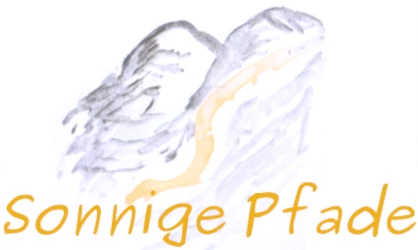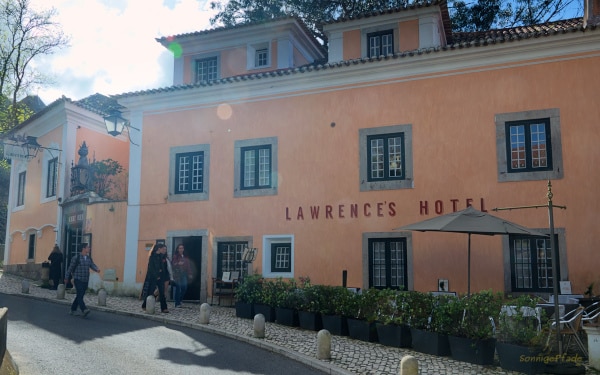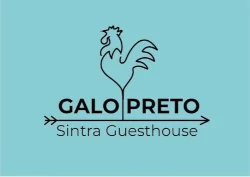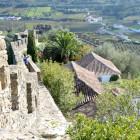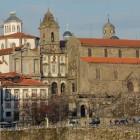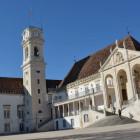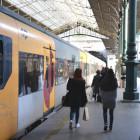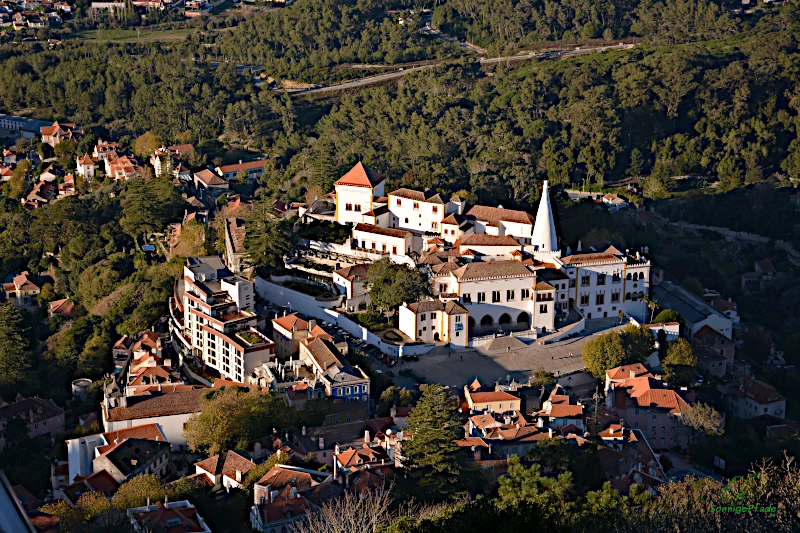
One of the highlights of a trip to Portugal can be a visit to the region around Sintra. Situated about 30km west of the capital Lisbon, Sintra offers an impressive landscape with the Serra de Sintra and above all a number of palaces, castles and other witnesses of the past. Some of them host exhibitions of contemporary art or historical show. It is not without reason that the Sintra region has been a UNESCO World Heritage Site since 1995. An impressive end of the Sintra exploration can be a visit to the „Cabo da Roca“ – the westernmost point of continental Europe high above the Atlantic Ocean.
For your visit to the Sintra region you should allow at least 2 or 3 days.
In the city of Sintra
Sintra itself as an old city has a worth seeing core with partly narrow winding alleys. Many palatial mansions characterize the picture, as soon as you travel a bit from the center towards the mountains. In Sintra, the royal Palácio Nacional de Sintra is the most prominent group of buildings and the most famous sight. Especially the two conical chimneys of the palace kitchen catch the eye. That’s what I call a fume hood – there were certainly no problems with kitchen odors!
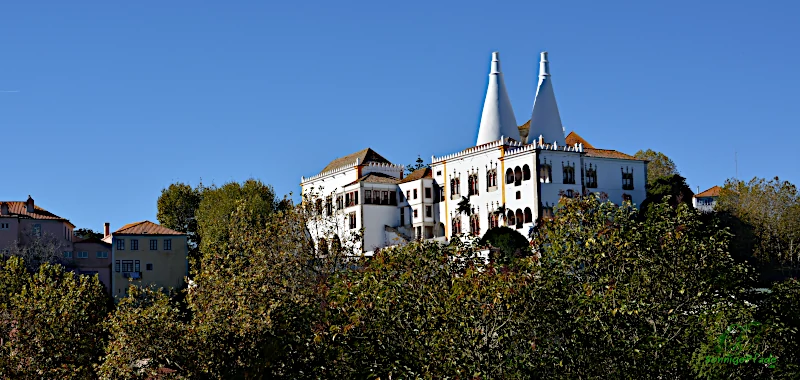
The palace is also called Palácio da Vila or Paço Real. These building originally dates from the 15th century and was built on the foundations of a Moorish palace complex as a summer residence. The original Renaissance-style interior was redesigned after the earthquake of 1755, often using ceramic mosaics with azulejos. One of three halls to be highlighted is the Hall of Magpies, whose ceiling holds 136 magpies. These represent 136 chattering maids, who are said to have diligently fueled the rumor mill and „tipped“ the queen to a transgression by the king. Notable attractions also include the Hall of Heraldry and the Hall of Swans.
Quinta da Regaleira is another palatial mansion with a magnificent park on the hillside of the Serra de Sintra. The 1910 neo-Gothic style palace includes a chapel as well as fountains, small lakes, a waterfall and grottoes with tunnel system in the 4ha park.
However, I didn’t spend that much time in the city itself. The mountains of the Serra de Sintra lure too much, especially with the already widely visible Moors – fortress.
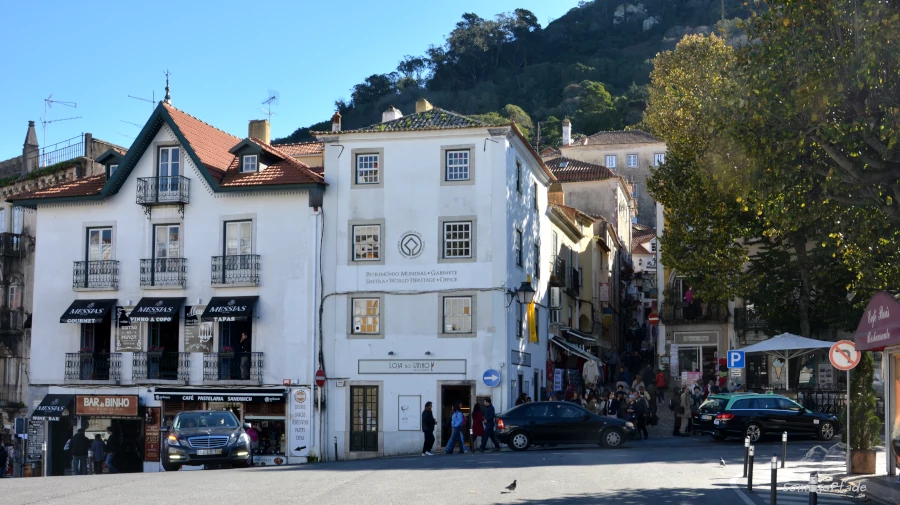
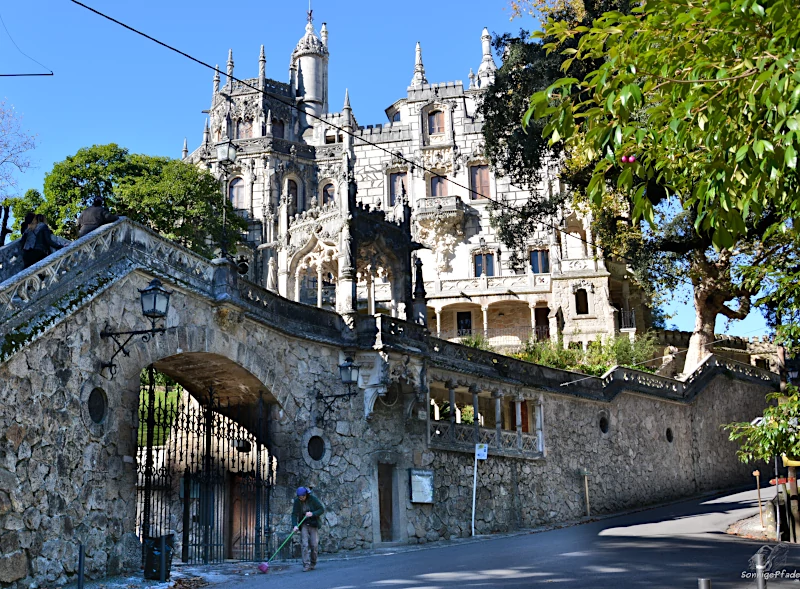
Castelo dos Mouros – the Moorish fortress
High up on the mountain ridges above the town of Sintra, walls with turrets and battlements dominate the picture – a fortress from the times of the Moorish settlement of the Iberian peninsula. I make my way there on foot – first along some narrow and shady streets between the high walls of the park-like estates. Then my path turns into the garden at Vila Sassetti, which is on the first major incline. The paths are shaded by trees and quiet, especially since the road winds up the hill in wide switchbacks a little distance away. For this I have to cope with some stairs as a climb from time to time.
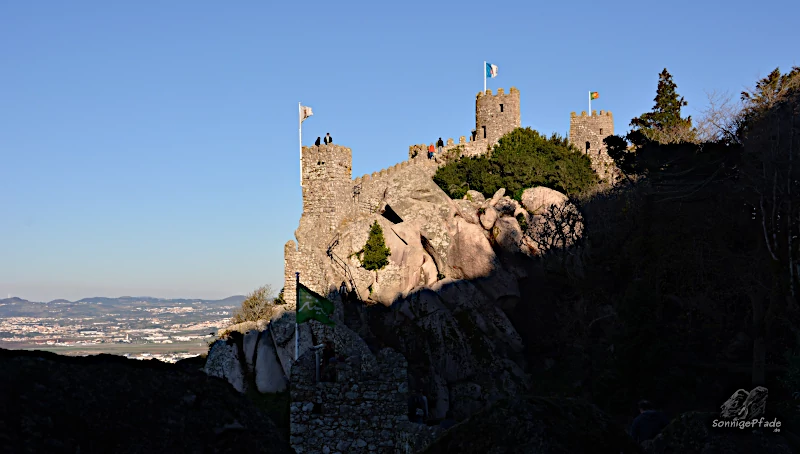
Castelo dos Mouros, the Moorish fortress is located on a hilltop in the Serra de Sintra. Towards the valley, a mighty wall with several watchtowers stretches out, from which one already has a good view far into the country north of Sintra. And you can see the coastline and the Atlantic Ocean. The fortress was once built for this purpose – the Moors had a firm grip on the southern part of the Iberian Peninsula for several centuries. But this required control of land and sea, precisely from such strong fortresses.
Behind the walls, other traces of buildings can be discovered, as well as round „cauldrons“ cut into the rock. These were probably granaries for grain, which could be stored in them in a manner impervious to mice. A large cistern made it possible to store enough water supplies for long sieges. Stables, guardrooms and a prayer house were part of the facilities. After all, this fortress complex is over a thousand years old – it dates back to about the 9th century. For a long time the complex was fought over. Again and again, Christian armies tried to oust the Islamic Moors from the Iberian Peninsula. There were also frequent battles around Sintra. It was not until 1147 that the Moorish fortress near Sintra was conquered by the Portuguese King Alfonso I and held permanently.

Pena Castle – the „Portuguese Neuschwanstein“
Over a mountain saddle and a bit further up, we find another attraction of Sintra, the Palácio national de Pena. This is a bit of a „fairy tale castle“ for romantic stories, but this palace is not old. The Pena Castle was built only from 1840. A comparison with Neuschwanstein Castle in Bavaria is not so wrong – Pena Castle is said to have inspired the Bavarian – King Ludwig II to build the same.
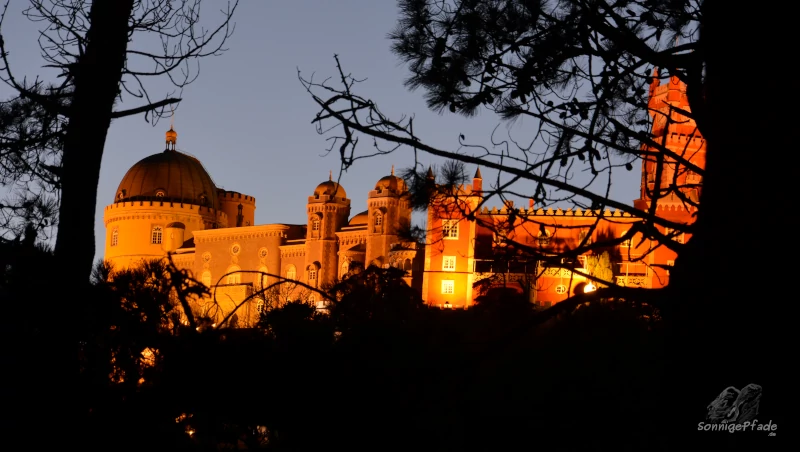
Actually, everything is „Neo“ – elements of Neo-Renaissance, Neo-Gothic, Neo-Manuelinic, Neo-Baroque and Neo-Rococo can be found close together in the Pena Palace. Even the composer Richard Strauss is said to have been overly enthusiastic about the fairy-tale Pena Palace. Sure, the sight of the buildings rising in bright colors from the green of the mountain slopes is already remarkable. However, some details, seen from close up, can quickly leave a rather cluttered impression.
The Palácio de Pena, by the way, is also called „sorrow castle“ despite this splendor. „Pena“ means sorrow, sadness. … thus everything else than a joy – fairy tale. This name derives from a monastery that used to stand on the site. The monastery was also largely destroyed in the severe earthquake of 1755. The weakened order never really got back on its feet, so the site was abandoned at the beginning of the 19th century. The Portuguese King Ferdinand II bought the land and began building the Palácio de Pena.
Your entrance ticket for Pena Palace and Pena park you can get here online*.
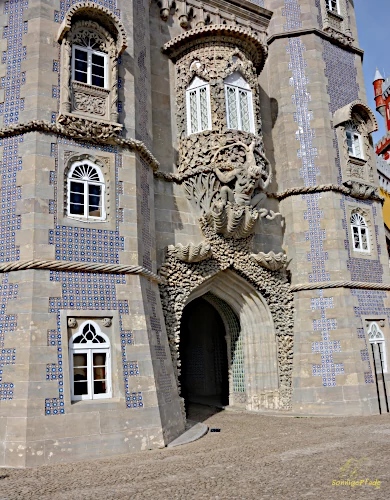
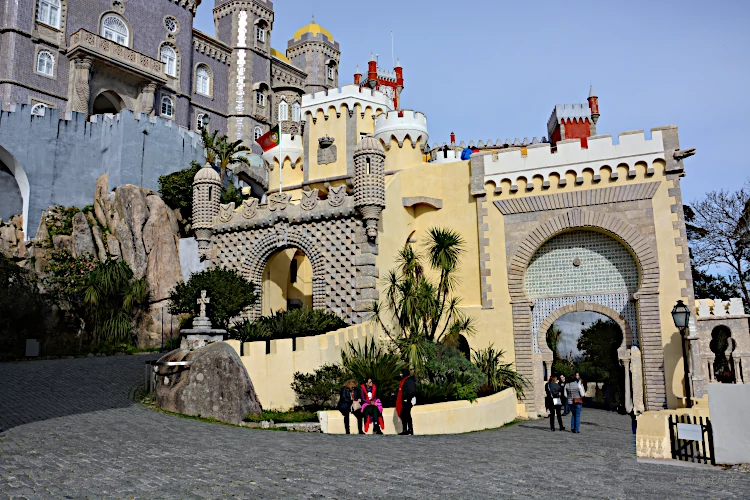
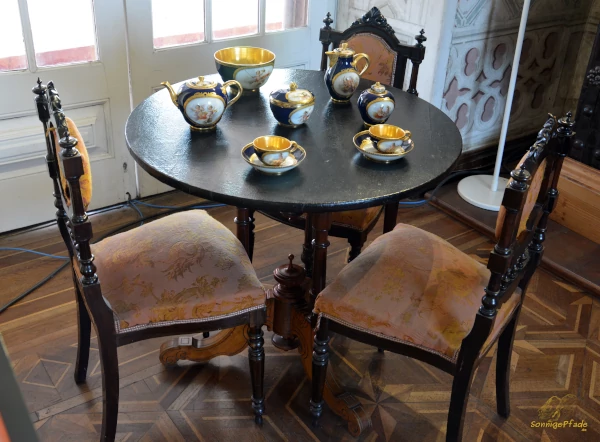
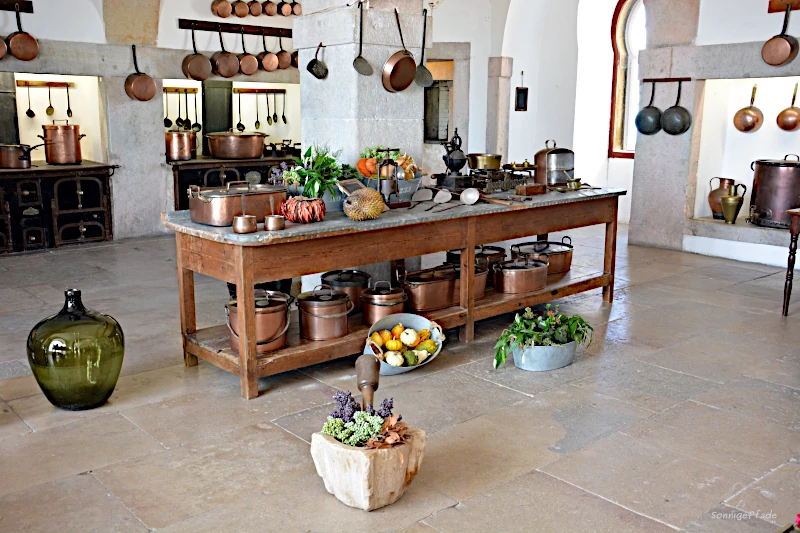
Parque de Pena and Cruz Alta
The park at the Pena Castle is also one of Sintra’s World Heritage Sites. Especially those who are interested in botany and dendrology will enjoy the variety of plants and trees of different species. Allegedly, during the construction phase in the middle of the 19th century, the slope at the Palácio de Pena was bare like a lunar landscape and was also called Monte da Lua – Moon Mountain by the locals. With the creation of the park, more than 200 different native, as well as exotic plants and trees came into the ground. The collection ranges from camelias, azaleas and rhododendrons to mighty redwood trees. Thick cork oaks with their angular cork barks are impressive, as are Tasmanian tree ferns that overgrow cross-hanging branches in the maritime wet climate and, together with mosses, create a quaint character.
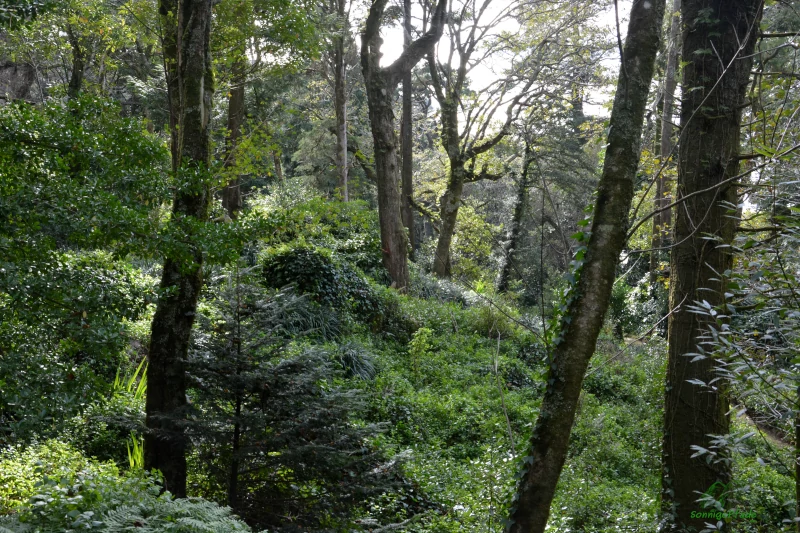
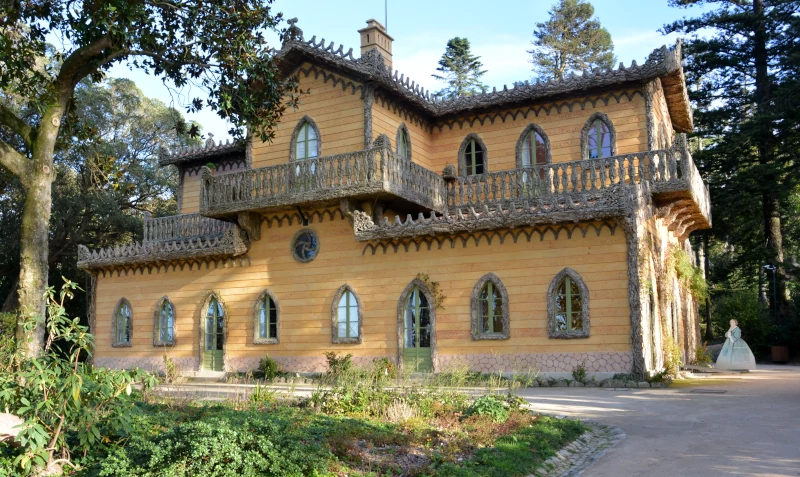
In the park is the highest elevation of the Serra de Sintra with the „Cruz Alta„, a stone cross on a rocky peak (528m). From there you have an excellent panoramic view over Lisbon and the wide estuary of the Tagus, the mountain forests around Sintra and the Atlantic coast in the west.
If you spend more time in the Parque de Pena, you can discover other buildings such as a gardener’s house, greenhouses where fresh young plants grow, or the Chalet da Condessa d’Edla. Interesting as a detail is that the flaps of the windows, balcony railings as well as eaves fascias have all been covered with cork panels. Also inside the chalet walls are covered with cork inlays.
The Chalet da Condessa d’Edla is located in the western part of the Pena Park, surrounded by the garden of the same name of Condessa Elise. The latter was the mistress of King Fernando II, who wanted to marry Elise at all costs, which meant a scandal in Portugal at that time: Elise was from Switzerland and was a famous opera singer in America. She already had a daughter by an unknown father and was of non-noble birth. King Fernando II pressed his cousin Ernest II Duke of Saxe-Coburg and Gotha, who ennobled Elise with the title of Condessa d’Edla. The house in Pena Park was designed and built „single-handedly“ by the lovers in the style of a Swiss chalet.
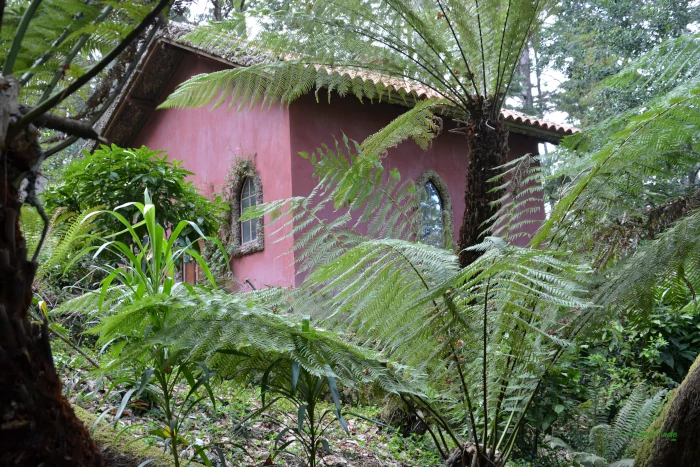
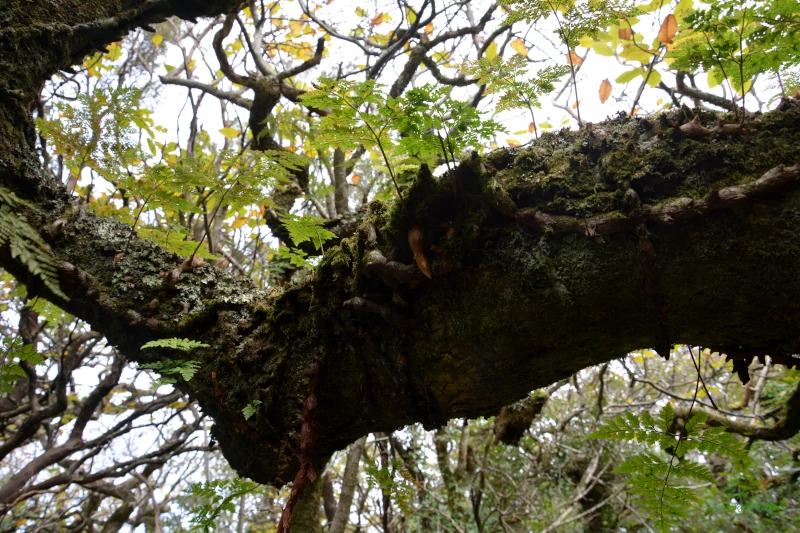

Convento dos Capuchos – the Cappuchino Monastery
West of Pena Park, you’ll find another Sintra sight worth visiting – the Convento dos Capuchos. For me, for the sake of simplicity and easier to remember, it was the „Cappuchino – Monastery“. Although this is not true – the „Capuchos“ are Franciscan – monks. „Capuchinhos“ are called Capuchin monks in Portuguese.
I walked there, but that is not necessarily recommended. Because the way to the Capuchos – monastery, about 6km away from Sintra, inevitably leads over a narrow, tiring tarred road. Alone from the garden of the Condessa d’Edla in the Pena Park it is about 4.8km.
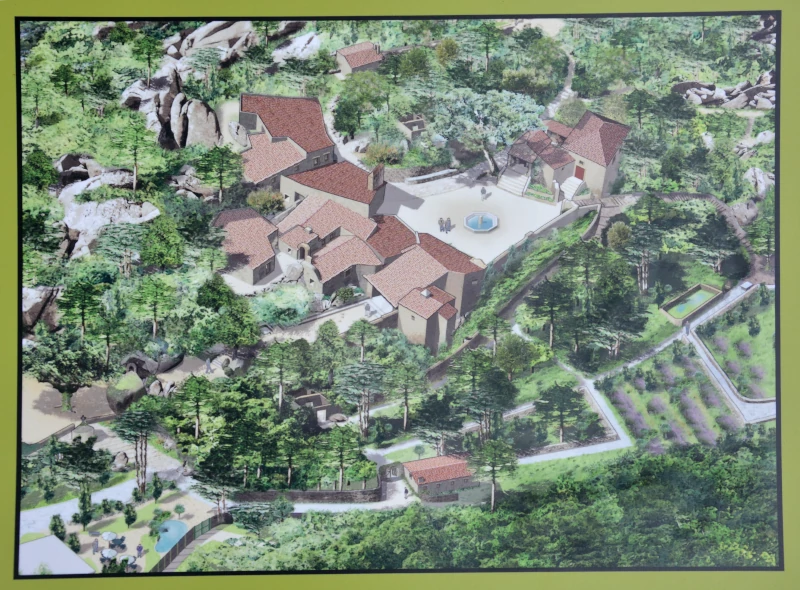
The complex of the old monastery „to the holy cross“ is not very large, but already special. It is hidden deep in the forest. The foundation of the monastery in 1560 goes back to Alvaro de Castro. According to legend, his father, Joao de Castro, Viceroy of India, got lost while hunting and lay down to sleep on a rock. In a vision he is said to have received the order to found the convent on this spot, which his son took over for him after his death.

The compact complex of the Convento dos Capuchos nestles tightly against a rock. Some of the rooms have been carved into the stone. Life there must have been very austere. Small dark cells were little better than some caves. When I visited the chambers, everything was damp and cool and it smelled of mold in many places. Not imaginable to live there for a few days, let alone spend a lifetime. Nevertheless, the ensemble also conveys a sense of shelter – due to its structural tightness. With a community of spiritually close people, far away from all civilization, that has something. Sitting together in the evening on the small square by the fountain, making music or telling stories… Apart from the „structural defects“, this place is an idyll. A visit early in the morning is recommended, if possible before too many visitors blur the impression of seclusion.
As usual in monasteries, there is a herb garden and some botanical treasures to discover in the grounds.
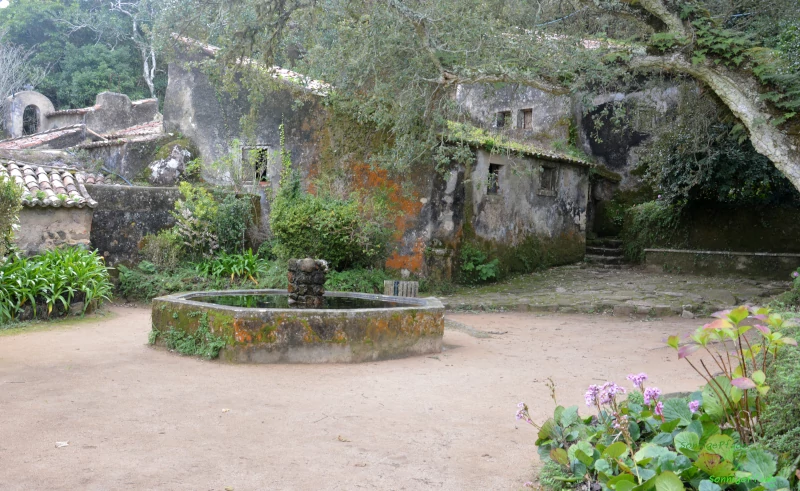

The westernmost point of continental Europe – Cabo da Roca
West of the Serra de Sintra, where the foothills of the mountains meet the Atlantic coast, is Cabo da Roca. This is the westernmost mainland point in Europe. Over impressive cliffs, the view reaches far out to the sea, which violently crashes onto the rocks. A stone pillar with a cross marks this point about 140m above sea level, which definitely attracts some visitors. A few meters away, in a closed courtyard, is the lighthouse for this landmark.
Patient nature lovers can discover not only the widespread kestrel (falco tinnunculus) but also the rare peregrine falcon (falco peregrinus) breeding in the rock walls. Also the crow cormorant (phalacrocorax aristotelis), a relative of the cormorant, is found in the coastal cliffs. The rocky cap is overgrown by the edible marigold, also called horse fig (Carpobrotus edulis), which has fleshy red-gray-green leaf bodies and yellow flowers.


[Contains *advertising]
Visiting tips for Sintra
Your way to Portugal is shown in the extra travel – to – Portugal post!
How to get to Sintra
Sintra can be reached quickly from the Portuguese capital Lisbon. The regional train Linha de Sintra runs at frequent intervals from Lisbon Rossio station directly to the world heritage city. From the station it is only a few minutes walk to the historic center.
If you will go and visit Sintra in a guided Tour from Lisbon, there is an offering including Sintra*, Pena Palace, Cabo da Roca and Cascais in one day.
For train and bus information and online ticketing you can check the omio* website.
Getting around Sintra
If you have enough time, you can explore a lot on foot. The city center of Sintra anyway, but also to the Moorish fortress Castelo dos Mauros or the mountain castle Pena there are hiking trails through the green hillsides – at least partly off the streets. The remote cappuchino monastery Convento dos Capuchos can unfortunately only be reached on foot or with your own means of transport (rental bike, rental car: Campo Raso Sintra*).
An alternative with less walking are the light green electric Hop On Hop Off vehicles that connect stops at Park de Pena, Chalet of the Princess d’Edla and Park de Monserrate. The vehicles, open on the sides, even have a compartment accessible to wheelchair users.
Similarly to the famous old town of Óbidos, in a horse-drawn carriage you can also explore the Park of Pena with its ponds and the garden and chalet of the Condessa d’Edla. In this way of transportation, the vast parks of Pena become accessible even to guests who are not so good on foot.
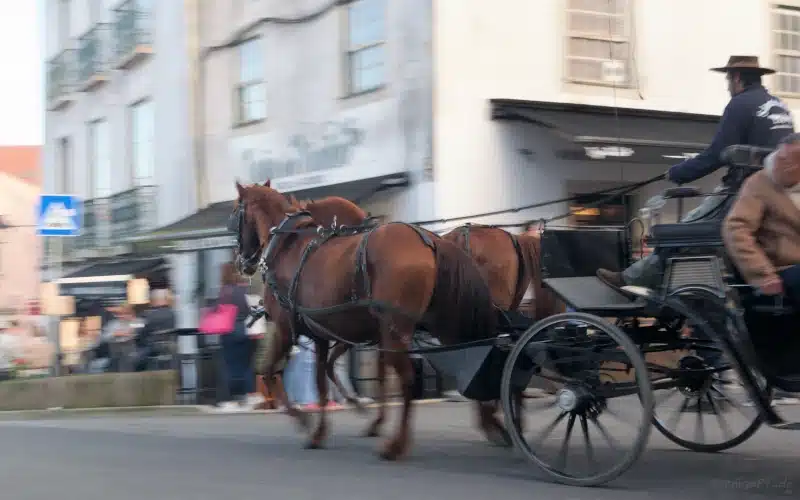
Those who want to make their visit to Sintra even more adventurous can continue their exploration on horseback. Guided horseback tours are arranged by Parques da Sintra together with the tourist information office. Adults ride on saddled horses, for children ponies are kept for trial riding. www.parquesdesintra.pt, eMail: info@ parquesdesintra.pt
Sintra also offers good local bus lines, so that you can walk one way and take the bus the other way. The local bus line 434 goes to the Moorish Fortress and to the Pena Castle/Park. Cabo da Roca is the terminus of one of the local bus lines (403) and is served regularly.

In summer, an electric streetcar runs from Sintra via Colares (to there along the EN247 road) to Praia das Macás, stopping practically next to the large beach.
Current weather in Sintra
In the adjacent graphic you can find the current weather report for Sintra region in Portugal.
Accommodation in Sintra – hotels, apartments and hostels
The choice is yours – of course you can also stay in Lisbon and take the regional train from there to Sintra. For a quick impression of this world heritage region, this might be enough. However, if you want to get to know the region more thoroughly, more slowly and more thoughtfully, a nice accommodation directly in Sintra is recommended. Then you can make various excursions, enjoy the museums and exhibitions, discover the nature of the Serra de Sintra and the coastal landscape and in the evening, when the day tourists have disappeared, let the small town flair of Sintra take effect on you.
Friendly apartments in historic houses of Sintra
Light-filled, airy and spacious rooms are part of the hotel offer at Hospedaria Cafe Pielas*, about 1km from the Palacio Nacional de Sintra and the center. In-house cafe and bar, as well as several restaurants and other Portuguese cafes in the nearby area, provide ample refreshments before and after exploring the city and visiting the many sights in Sintra and the surrounding area. All rooms have shower/bath and coffee/tea accessories.
Sleeping 4 to 6 guests, the large apartments at Villa Alba in Sintra* have fully equipped kitchenettes with refrigerators, kettles and microwaves. Superbly rated accommodation just about 700m from the Palacio Nacional de Sintra, best place to rest before or after sightseeing in an old Portuguese villa.
Also highly rated are the apartments of Villa Municipio „urban chic „*, about 300 m from the city center and the National Palace of Sintra. The apartments accommodate two to 4 , with extra beds up to 6 guests. Kitchens are available. The ground floor apartment is accessible without steps, disabled parking is available at the house. Cafes and restaurants can be found in the immediate vicinity. Villa Municipio apartments are among the best rated accommodations in Sintra.
Healthy food and country air – Galo Preto Bed & Breakfast
About 3 km outside Sintra, Galo Preto Urban agriculture* offers excellent rural accommodation in rooms for two to three guests. The breakfast buffet offers healthy food options mostly from their own garden. On the sun terrace, sunshades and the garden furniture can be used for relaxation. Parking is available free of charge at the house. There is also a golf course nearby.
Hostels – budget in Sintra
The small cozy Nice way Sintra Hostel* offers dormitory beds, but also private rooms from 2 to 4 persons and family rooms with bathroom or shared bathroom. A shared kitchen and a barbecue in the garden can be used for individual meal preparation. The Nice way Hostel is only about 300m away from the Sintra National – Palace, to the Pena Palace it is about 1,5km. Movie nights and dinner evenings are among the hostel’s evening activities. Bicycles can be rented for a fee. There’s an indoor play area for kids.
One address to reach quickly: Moon Hill Hostel in Sintra* is just about 300m from the train station and offers dorm beds and a range of accommodation options from twin to family rooms, including with private or shared bathrooms. Daily there is a breakfast – offer. Other meals are available in the in-house restaurant. Access to Sintra Moon Hill Hostel is wheelchair accessible. It is about 200m to the Sintra National Palace. The Moorish Fortress (700m) can already be seen from the courtyard. To the Pena Park and Palace it is about 1,5km.
Caravan place: Sintra Vintage Caravan with sea view
A bit outside of Sintra and already with sea view, the Sintra Vintage Caravan* offers pitches, but also some rooms for up to 4 guests. These are on the ground floor and are easily accessible for those with walking difficulties. An outdoor pool is part of the complex. Washing machine, kitchen and shared bathroom are available. It is about 2.8km to Praia Pequena do Rodizio beach. The National Palace of Sintra is about 9km away.
3 days discovery in the World Cultural Heritage Sintra – it could look like this:
Day 1 – Sintra city explorations
Arrive in Sintra, check in at your accommodation and drop off your luggage.
Then a day in the city itself with a visit to the Palácio Nacional de Sintra, strolling around the city, enjoying modern art in the Museu de Arte Moderna or sculpture – art in the Museu Anjos Teixeira
Discover Sintra at the time of the Romans in the Ruínas de São Miguel de Odrinhas (by bus, about 10km north).
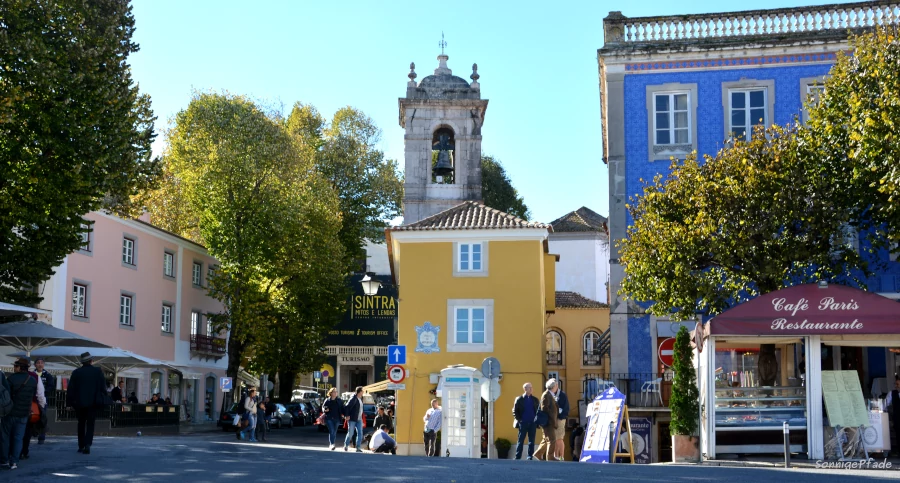
Day 2 – Moorish Fortress and Pena Palace, Pena Park
Visit the Moorish Fortress, the Palácio Nacional de Pena and the Parque de Pena: This will be a „full day – event“! Anyway, if you do not just run through everywhere and want to shoot 2, 3 insta-photos. For this, it’s not a bad idea to pack some food and definitely water. On the way up the mountain and in the park you are longer on the road, quite a bit away from snack – facilities. You can climb the mountain path in the park of Vila Sassetti and take the bus for the way back (ask in time about the last trips back).
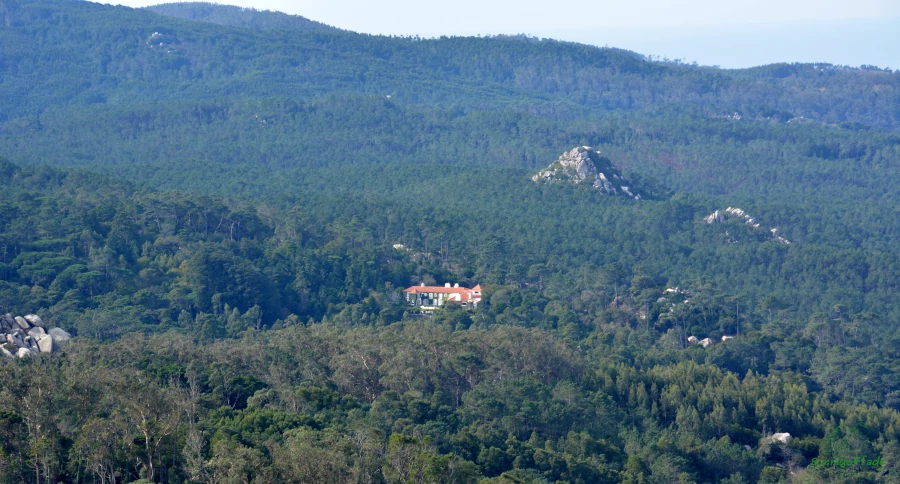
Day 3 – Convento dos Capuchos and the westernmost point of Europe
Visit to the Cappuchino Monastery. The hike from Sintra to the Convento is about 6,8km, overcomes about 200 meters of altitude and takes about 1,5 hours. Or take a rental bike or rental car* and arrive at the Convento dos Capuchos before the crowds of visitors, right after the morning opening. Then you can jump back in time to the 16th century. If necessary, there are cabs or other privately organized means of transportation to the Cappuchino Monastery. This would be a prerequisite for the following hike:
From the Cappuchino Monastery you can get to Colares on a hiking trail Caminho dos Carreiros. At first, the path leads through beautiful mountain forests. Later, the view opens up and you get a glimpse of the landscape and the Pena Castle from a different perspective. From Colares you take the bus directly to the Cabo. Also back to Sintra there is a bus from Cabo da Roca.
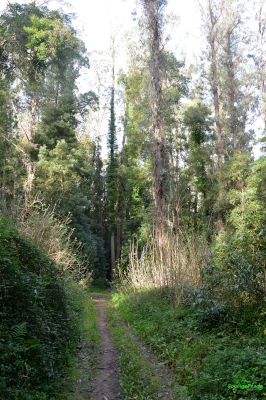

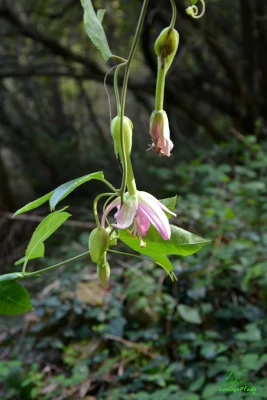
If you have booked another (3rd)night in Sintra, then enjoy a relaxing evening and consider seeing something the next morning. (There are more villas and palaces such as Quinta da Regaleira and also a military historical aviation museum in Sintra).
From Sintra you can easily continue north to Óbidos, a famous small town with complete city wall and Peniche, the surfspot at the Atlantic coast.
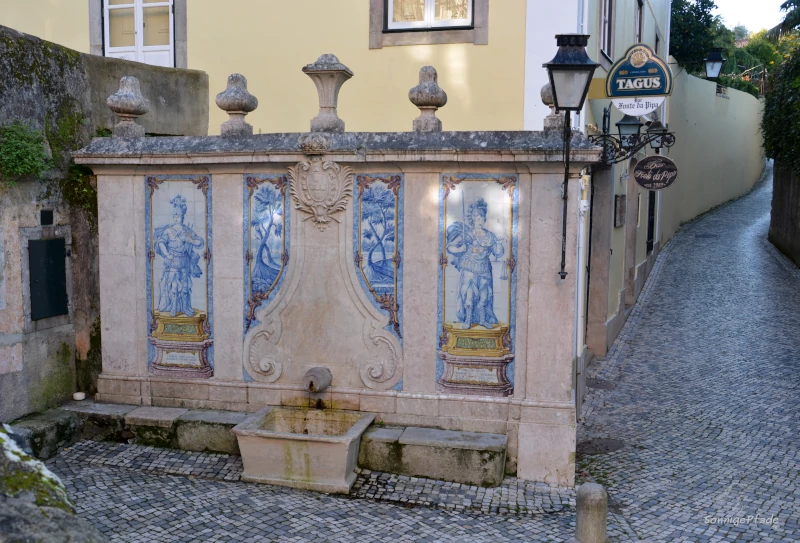
More tips for your individual Portugal journey?
Visit Obidos, the portugese Queen’s town with complete walkable town wall
A look in the north – Porto, city with special „house wine“ at the Douro river
Coimbra – University town with a long history
General tips to organize your individual Portugal trip
Beautiful days in Sintra? Share the link!
I hope I could give you some good tips for your stay in the world heritage region Sintra. If so, I’d love to hear from you (maybe with some highlights of your visit to Sintra) and don’t forget to share the link to the Sintra post on your social media channels!
Reference to advertising links
Some links are marked with * and connect to stores or online offers. If you click on such a link and buy something in the store, I receive a small commission to finance this blog. Nothing will be more expensive for you, because the commission has already been taken into account in the pricing.
Source product images: Manufacturer/ Dealer
